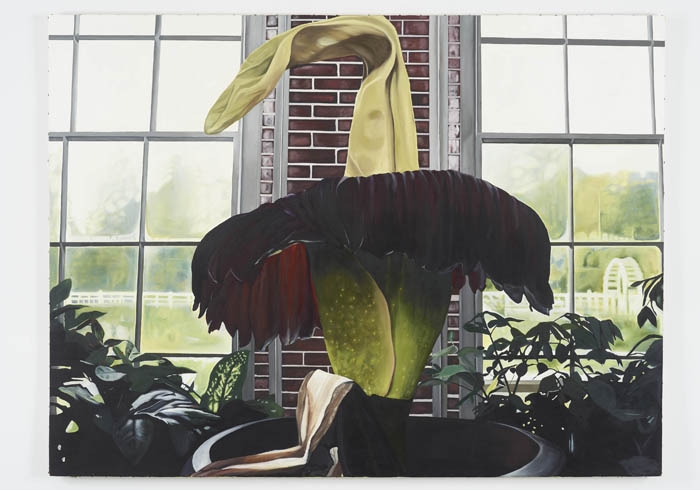David Lewis, New York, 28 June – 20 August
Each of the seven monumental paintings here feature the same species of giant potted flower – a leviathan with large petals of deep Bordeaux purple that enfold a sinewy, skyscraping stalk. Pictured in various stages of blooming and dying, they look like something Louise Bourgeois would have made in bronze – bodily and macabre.
While Megan Marrin has had a handful of two-person shows over the past five years, this marks her first solo exhibition and something of a departure in subject matter from her previous work. For Corps, the artist has painted seven iterations of the titan arum, a plant better known as the corpse flower, so called for the smell of rotting carcass it releases upon blooming. This bloom lasts 24 to 36 hours and, in cultivation, takes ten years to produce.
I’d somehow missed last summer’s furore over the New York Botanical Garden’s blooming corpse flower and I saw this show twice without really knowing exactly what I was looking at. Subsequent research revealed that much spectacle is made of this plant. According to Wikipedia, it hails from ‘the equatorial rainforests of Sumatra, Indonesia’ and is firmly part of the colonial tradition of exhibiting foreign things for Westerners to be repulsed and intrigued by. Indeed, the flowering of these jungle plants has become an event guaranteed to provoke an exoticising hubbub that draws crowds to botanical gardens across the US and Europe.
Marrin’s paintings emphasise that a specifically bodily desire fuelled the Enlightenment era’s obsessive cataloguing
In a way, Marrin’s paintings are an extension of this phenomenon, as they are each copies of images of the plant found online – a cursory search turns up a handful of the photographs she’s chosen, all of which show the plant in greenhouses, or in captivity, so to speak. Some of the paintings include posing or gawking human figures, a feature that seems to emphasise the schoolboy joke of the plant’s name in Ancient Greek: Amorphophallus titanum or ‘giant misshapen phallus’.
The strongest paintings are the ones that show the flowers on their own, perhaps because they seem more sincere. There is no distraction from the care she has taken with lush pools of pastel pink, green and burgundy to form the fleshy body of the plant. While the composition of the painting is predetermined by its source material, the size feels purposeful. The 2.4m-tall canvases are about the size of the actual flower, and they’re hung almost touching the ground, reinforcing a bodily encounter between plant and viewer.
The botanical gardens that house titan arums often christen them with women’s names, eg Trudy, Alice, Morticia – but Marrin’s titles are more libidinous. She has called them The Breed (2016), The Hunger (2016), The Invitation (2017). Marrin’s covetous titles don’t simply point to our desire to know the alien. In their references to corporeal craving, they emphasise that a specifically bodily desire (rather than neutral system-making) fuelled the Enlightenment era’s obsessive cataloguing – in greenhouses and otherwise. While I’m not sure these paintings totally transcend our cultural impulse to fetishise otherness, they certainly point it out to us.
From the October 2017 issue of ArtReview
